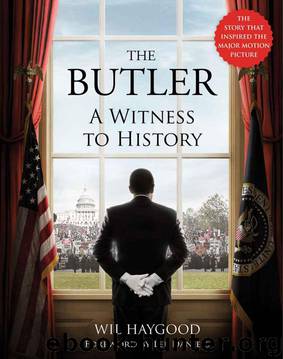The Butler: A Witness to History by Wil Haygood

Author:Wil Haygood [Haygood, Wil]
Language: eng
Format: epub, mobi
ISBN: 9781476752990
Amazon: 1476752990
Publisher: 37 Ink
Published: 2013-07-30T07:00:00+00:00
LOUIS
Sidney Poitier is the white man’s fantasy of what he wants us to be. Well behaved with no sense of his manhood as a sexual being.
CECIL
But his movies have him fighting for equal rights.
LOUIS
Only in a way that is acceptable to the white status quo.
It was impossible for Hollywood to ignore how this sentiment was expressed through the upheaval on the streets. In Los Angeles—the movie capital of the world—the community of Watts erupted in a riot on August 11, 1965. Thirty-four people died. The Los Angeles Times, a newspaper both rich and fat at the time, did not have a single black reporter on its full-time staff. They corralled a black messenger to get to the scene and take notes. In Watts, the world could now see, in newsreel footage, the painful woes of inequality that engulfed the country. Filmmakers in the land of sunshine seemed caught in a time warp and spasms of denial. Cinema was right out their front door. Directors were churning out big-budget flops like Dr. Dolittle while fires raged not many miles from the movie studios themselves.
What did slip through, though, as a kind of multicultural filmmaking moment, was the experimental era of so-called blaxploitation films. Beginning in the 1970s, those films landed in many urban theaters around the country. Nowadays many look dated and seem comically retro. The budgets were indeed low, but the films were imbued with an undercurrent of activism: the male and female stars were anything but subservient or acquiescent. They were aggressive, cool, defiant. They were rebels with causes. On-screen, their afros bobbed in the wind. Their bell-bottoms flared. The dialogue—“whitey,” “hey brother,” “the man,” “dig it”—echoed the patter on the nearest urban street corner. Black moviegoers suddenly had heroes that looked like them, and they flocked to see the movies, among them The Mack, Foxy Brown, Shaft, Truck Turner, Cleopatra Jones, and Super Fly; the latter had a soundtrack by Curtis Mayfield that would become a classic. The films also provided work for a coterie of black actors who welcomed the opportunity, among them Calvin Lockhart, Ron O’Neal, Bernie Casey, Julius Harris, Sheila Frazier, Richard Pryor, Pam Grier, and Billy Dee Williams.
Then something mighty strange happened in the world of blacks in cinema. The latter half of the 1970s was barren. Blacks actually began to disappear from film. Years rolled by with large swaths of black talent on the sidelines or struggling to get television work. It seemed, in the land of so-called liberal Hollywood, that even the subject of blacks in movies was taboo. The editors of People magazine thought otherwise. Their 1982 article “Blacks in Hollywood: Where Have They All Gone?” flung the issue out in the open, where it could not be ignored any longer. The article was scathing and blunt: blacks, it charged, were being “whitelisted” from Hollywood motion pictures. (The term, of course, played on the infamous word “blacklisted” used to describe members of the Hollywood community denied work in the 1950s because of alleged ties to Communist sympathizers.
Download
The Butler: A Witness to History by Wil Haygood.mobi
This site does not store any files on its server. We only index and link to content provided by other sites. Please contact the content providers to delete copyright contents if any and email us, we'll remove relevant links or contents immediately.
| African-American & Black | Australian |
| Chinese | Hispanic & Latino |
| Irish | Japanese |
| Jewish | Native American & Aboriginal |
| Scandinavian |
Becoming by Michelle Obama(9931)
Beartown by Fredrik Backman(5610)
The Last Black Unicorn by Tiffany Haddish(5563)
Man's Search for Meaning by Viktor Frankl(4439)
The Book of Joy by Dalai Lama(3904)
In a Sunburned Country by Bill Bryson(3486)
The Five People You Meet in Heaven by Mitch Albom(3476)
The Choice by Edith Eva Eger(3426)
Full Circle by Michael Palin(3394)
The Mamba Mentality by Kobe Bryant(3190)
The Social Psychology of Inequality by Unknown(2943)
Book of Life by Deborah Harkness(2869)
Imagine Me by Tahereh Mafi(2841)
The Checklist Manifesto by Atul Gawande(2784)
Less by Andrew Sean Greer(2647)
A Burst of Light by Audre Lorde(2549)
The Big Twitch by Sean Dooley(2394)
No Room for Small Dreams by Shimon Peres(2321)
No Ashes in the Fire by Darnell L Moore(2298)
